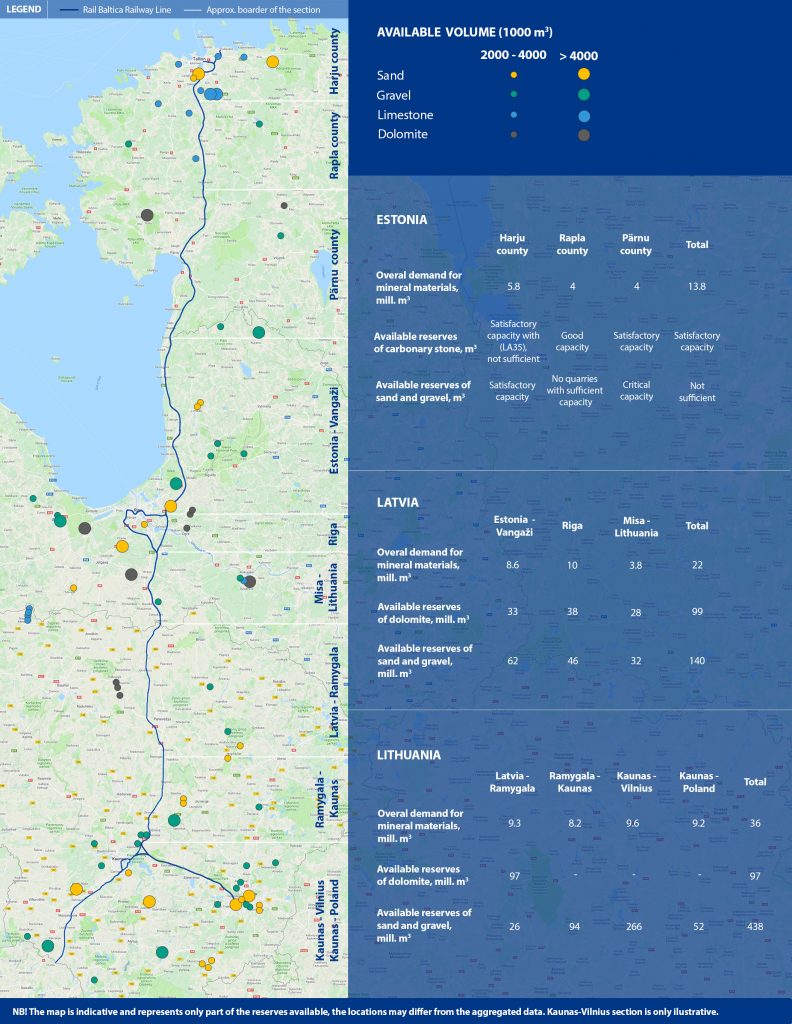RB Rail AS has carried out two desk studies on the supply of mineral materials for the construction of the Rail Baltica railway line in Latvia and Lithuania. Both studies were carried out by SIA Geo Consultants in cooperation with UAB Geobaltic and was completed in August 2018. In Estonia similar study was done by AS Teede Tehnokeskus in 2017 on behalf of Rail Baltic Estonia OÜ.
Rail Baltica project will require a large amount of mineral materials to be used in the construction phase. Thus, the overall demand of locally available mineral materials, sand, gravel, limestone and dolomite will considerably increase.
As it can be seen from the Mineral Material Quantity Assessment map, the overall demand for all aggregate types is 72 mill. m3 (Estonia – 14 mill. m3; Latvia – 22 mill. m3; Lithuania – 36 mill. m3), while the overall supply exceeds 700 mill. m3 (Latvia – 239 mill. m3; Lithuania – 535 mill. m3). Hence, it is possible to fully cover the mineral material demand with the local country resources, except section in Pärnu County, Estonia where further investigation must be carried out.
It is planned to use all the mineral materials as efficiently as possible, though more detailed volumes needed for the construction of the Rail Baltica will come by the end of the detailed technical design process. The target is to reduce the amount of mineral materials needed for the construction as much as possible, thus increasing the sustainability of the project and track maintenance.
Key objectives
- Legal framework analysis;
- Mineral material amount estimation and quality parameters analysis;
- Mineral material deposits analysis;
- The mineral material deposits survey;
- Further recommendations.
Key assumptions
As assumed the demand for materials to be used for the construction will be higher during the first three to four years when substructures, bridges, viaducts, access roads and road crossings will be built. Based on very general assumptions the following annual demand of locally available resources could be forecasted:

Studies findings
1. What kind of mineral materials are currently locally available? Are there enough reserves?
There are enough reserves of mineral materials, except ballast layer which will have to be imported from outside Baltic. Locally available mineral resources are sand, sand-gravel, dolomite and limestone. Supply of crushed hard stone for ballast layer is not considered as locally available in the required amount and quality as per collected data during studies.
2. What are the quality requirements for the mineral materials?
The quality requirements of the mineral materials are largely based on design guidelines for Rail Baltica railway line. International and national standards were used for identification and classification of mineral materials according to the granulometric composition as well as for the analysis of quality requirements.
3. Is there currently sufficient information available on the quality parameters of the quarry mineral materials?
Acquired data on the quality of locally available mineral materials are very fragmented and does not provide sufficient information on their compliance with the requirements set out in the Rail Baltica design guidelines. Thus, further studies will be carried out in the near future.
4. Does material supply logistics impose any significant constraints? What distance is considered to be sufficiently feasible from the Rail Baltica Railway corridor?
Material supply logistics does not impose any significant constraints in their transportation from the most feasible deposits. The distance that was studied is 60 – 130 km and it was determined that the quantity and availability of materials within area is fully sufficient for entire route of the Rail Baltica railway line. It is preferred to source the materials locally to decrease transportation distance, thus limiting the air pollution.
5. Would local producers be able to provide mineral materials in the required quality for the construction of Rail Baltica Railway?
The aim is to use as much as possible local materials and do it in the most efficient way. To assess the quality of the available mineral materials further investigation will be done during the Mineral Material Quality Assessment study. The procurement for Latvia and Lithuania was announced in September 2018. Learn more about it here: Quality assessment study on usage of local mineral materials for Rail Baltica Railway project. While similar procurement named Samples of Rail Baltica Mineral Resources and Laboratory Analysis was launched in October for Estonian sections.
6. Would it be required to consider opening new quarries?
It is determined that the mineral material reserves are sufficient. However, it should be noted, that the Rail Baltica project will not be the only construction project in Baltics, hence the local producers’ capacity to provide mineral materials with the current volume must also be taken into account. New quarry opening is up to the quarry owners. Additionally, from the project perspective currently it is not planned to open new ones, but the option for that is not ruled out.

